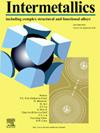nial基高熵合金的组织演变、加工硬化-动态软化转变及磨损性能
IF 4.8
2区 材料科学
Q2 CHEMISTRY, PHYSICAL
引用次数: 0
摘要
采用真空电弧熔炼法制备了价电子浓度为7的NiAl-CoCrxZryFez高熵合金(HEA)。系统研究了Zr含量对合金组织、力学性能和磨损性能的影响。显微组织分析表明,随着Zr的增加,共晶组织的体积分数逐渐增加,相组成由单一的BCC相演变为双相FCC + BCC结构。Ni30Al28Co15Zr7Fe20合金在600℃、800℃和1000℃的屈服强度分别达到1316 MPa、960 MPa和300 MPa,具有优异的耐高温软化性能。然而,热稳定性评估表明,Ni30Al28Co15Cr5Zr5Fe17和Ni30Al28Co15Zr7Fe20合金的共晶次级相在1000℃时变得不稳定,表现出相烧蚀的趋势。此外,Zr的加入将变形过程中从加工硬化到动态软化转变的温度窗口扩大了约200℃。高温摩擦学试验(600-800℃)表明,随着温度的升高,主要磨损机制从磨粒磨损转变为粘着磨损。Ni30Al28Co15Zr7Fe20合金在800℃时表现出优异的耐磨性,磨损率最低,为8.92 × 10−6 (mm3/N·m)。这种增强归因于zr诱导的固溶体强化,它提高了硬度,有效地减轻了分层磨损机制,从而保持了优异的高温耐磨性。本文章由计算机程序翻译,如有差异,请以英文原文为准。
Microstructure evolution, work-hardening-dynamic softening transition and wear performance of a NiAl-based high-entropy alloy
This study fabricated a NiAl-CoCrxZryFez high-entropy alloy (HEA) with a valence electron concentration (VEC) value of 7 via vacuum arc melting. The influence of Zr content on the alloy's microstructure, mechanical properties, and wear performance was systematically investigated. Microstructural analysis revealed that increasing Zr progressively enhanced the volume fraction of eutectic microstructure, while the phase composition evolved from a single BCC phase to a dual-phase FCC + BCC structure. The Ni30Al28Co15Zr7Fe20 alloy exhibited exceptional resistance to high-temperature softening, achieving yield strengths of 1316 MPa at 600 °C, 960 MPa at 800 °C, and 300 MPa at 1000 °C. However, thermal stability assessments indicated that eutectic secondary phases in both Ni30Al28Co15Cr5Zr5Fe17 and Ni30Al28Co15Zr7Fe20 alloys became unstable at 1000 °C, exhibiting a tendency for phase ablation. Furthermore, Zr addition broadened the temperature window for the transition from work-hardening to dynamic softening during deformation by approximately 200 °C. High-temperature tribological tests (600–800 °C) revealed a transition in the dominant wear mechanisms from abrasive to adhesive wear with increasing temperature. The Ni30Al28Co15Zr7Fe20 alloy exhibited superior wear resistance at 800 °C, achieving the lowest wear rate of 8.92 × 10−6 (mm3/N·m). This enhancement is attributed to Zr-induced solid solution strengthening, which improved hardness and effectively mitigated delamination wear mechanisms, thereby maintaining excellent high-temperature wear resistance.
求助全文
通过发布文献求助,成功后即可免费获取论文全文。
去求助
来源期刊

Intermetallics
工程技术-材料科学:综合
CiteScore
7.80
自引率
9.10%
发文量
291
审稿时长
37 days
期刊介绍:
This journal is a platform for publishing innovative research and overviews for advancing our understanding of the structure, property, and functionality of complex metallic alloys, including intermetallics, metallic glasses, and high entropy alloys.
The journal reports the science and engineering of metallic materials in the following aspects:
Theories and experiments which address the relationship between property and structure in all length scales.
Physical modeling and numerical simulations which provide a comprehensive understanding of experimental observations.
Stimulated methodologies to characterize the structure and chemistry of materials that correlate the properties.
Technological applications resulting from the understanding of property-structure relationship in materials.
Novel and cutting-edge results warranting rapid communication.
The journal also publishes special issues on selected topics and overviews by invitation only.
 求助内容:
求助内容: 应助结果提醒方式:
应助结果提醒方式:


